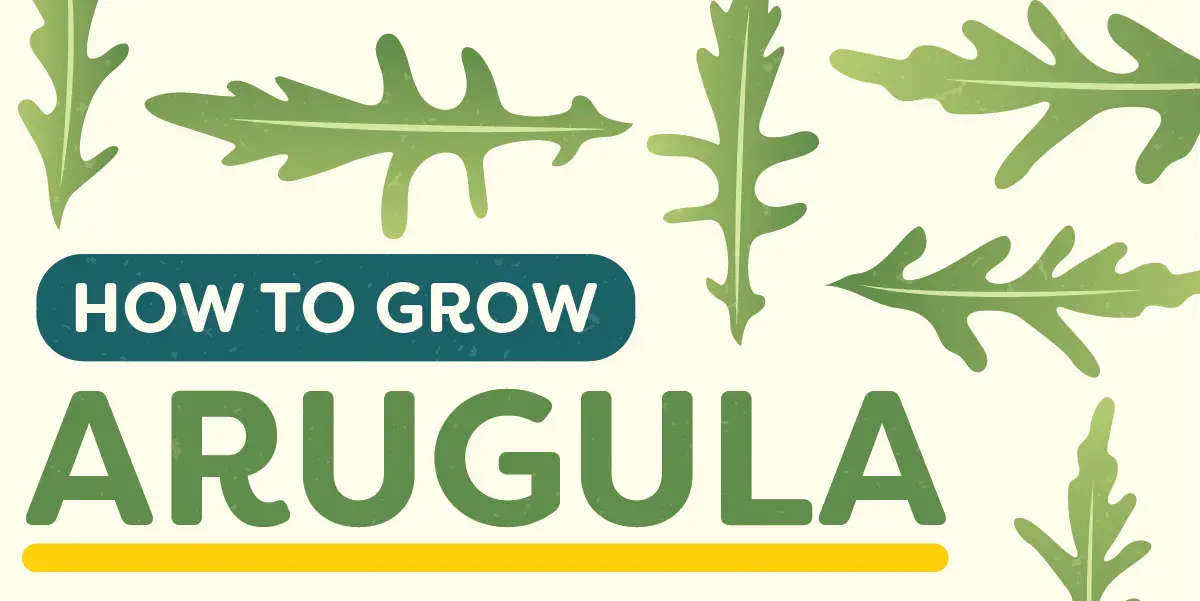Arugula is a leafy green with a distinct peppery flavor. It belongs to the Brassicaceae family, which includes mustard and cabbage.
It has been a staple in Mediterranean cuisine for centuries. Pliny the Elder wrote about it in the First Century AD.
The Romans considered it an aphrodisiac and used it as a culinary and medicinal herb. Maybe it can improve your love life. Plus, it’s fun to say: “a-roo-goo-lah.”
The plant does well in Southern California’s mild Mediterranean climate, where it grows year-round. So what are you waiting for? Start planting for better loving!
Types of Arugula
Varieties that thrive in Southern California include:
- Wild arugula (Diplotaxis tenuifolia) has smaller leaves and a more intense peppery flavor than its cultivated cousin. It’s highly drought-resistant and perfect for the drier regions.
- Cultivated arugula (Eruca sativa) is a fast-growing variety commonly found in supermarkets. It has a milder taste and larger, softer leaves.
- Wasabi arugula comes with a spicy, wasabi-like kick, which adds piquancy to salads.
- Apollo arugula grows well in cool and warm seasons, making it a year-round option. It has rounded leaves and a less peppery flavor.
- Dragons Tongue arugula stands out with its attractive purple veining. It shares the peppery taste of arugula but with a hint of nuttiness.
Arugula is a nutritional powerhouse high in vitamins A, C, and K. It’s also an excellent source of calcium, iron, potassium, and folate.
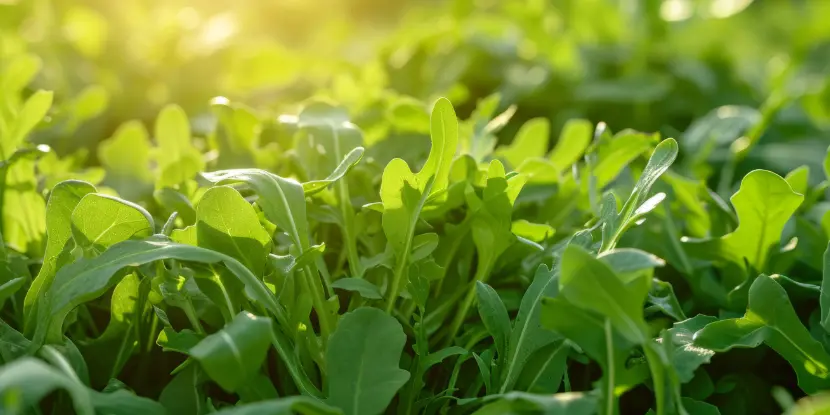
Healthy arugula in the garden.
Temperature & Soil
Climate
The optimal temperature range for growing arugula is between 45°F and 65°F. When the temperature exceeds this range, especially above 75°F, arugula tends to bolt, leading to a bitter taste and reduced leaf quality.
Soil Preferences
Arugula prefers well-drained soil rich in organic matter, with a pH between 6.0 and 7.0. Adding compost or aged manure can enhance soil fertility and structure.
Steps to Amend Soil
- Test your soil with a home testing kit.
- Add garden lime to raise the pH if the soil is too acidic (below 6.0). If it’s too alkaline (above 7.0), lower the pH with sulfur.
- Amend the soil with compost or well-rotted manure to improve soil structure, nutrient content, and water retention. This step is crucial for sandy loam or loamy soil.
- Blend a balanced, all-purpose organic fertilizer into the soil before planting arugula.
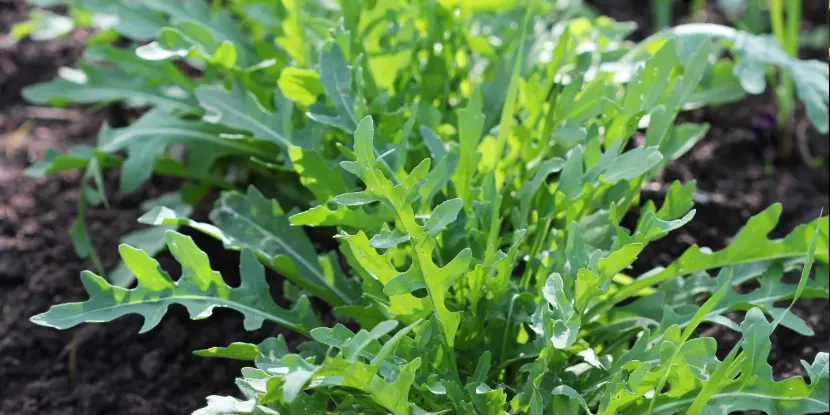
A row of arugula ready for harvest.
Planting Arugula
Arugula seeds can be sown directly into the ground or started indoors in seed trays. If planting outdoors, choose a spot with partial shade to prevent bolting (when the plant goes to seed quickly).
Southern California’s mild climate allows for planting nearly year-round.
- Fall Planting: Plant arugula seeds from September to November. This allows the plants to mature in cooler weather, which is best for leaf development.
- Spring Planting: You can also plant in late winter to early spring, starting in February and continuing through April. This ensures harvest before the hottest summer months.
Planting Process
- Loosen the soil to a depth of about 6-8 inches.
- Scatter the arugula seeds lightly and cover them with a thin layer of soil (approximately 1/4 inch). Arugula seeds need light to germinate but shouldn’t be planted too deeply.
- After planting, water the area with a light spray. Moisten the soil, but don’t saturate it. Keep the soil consistently moist until the seeds germinate.
- When seedlings are about 1-2 inches tall, thin them out so they’re spaced about 4-6 inches apart.
Seeds or Seedlings?
Arugula is usually grown from seeds, but seedlings can jumpstart your garden.
- The container or seed tray should have drainage holes. Fill it with a sterilized, seed-starting mix.
- Sow arugula seeds lightly on the soil’s surface, spacing them out as evenly as possible. Cover the seeds with a thin layer of soil or press them gently into the mix. Seeds need some light to germinate.
- Use a spray bottle to moisten the soil. This method won’t disturb the seeds or wash them away. Maintain consistent moisture without over-watering.
- Place the container in a warm, bright spot, but not in direct sunlight. Try to keep temperatures around 65°F to 70°F. If natural light is lacking, consider using a grow light.
- Arugula seeds typically germinate within 5 to 7 days. Once seedlings appear, give them plenty of light to prevent them from becoming leggy.
- Acclimate the seedlings to outdoor conditions before transplanting outdoors. Move the seedlings outside to a sheltered area for increasing lengths of time over a week to reduce the shock of transition from indoor to outdoor conditions.
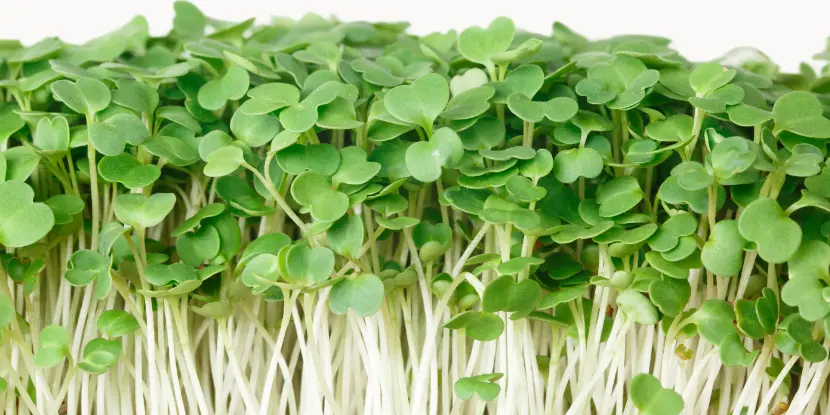
Arugula grown as microgreens.
Care Tips for Arugula
Keep the soil moist but not soggy. Mulching around the plants can help retain soil moisture and reduce weed competition.
Watering Techniques
Water deeply and less frequently to encourage root development. Overhead watering should be done early in the day to allow foliage to dry. Drip irrigation and soaker hoses are the most efficient methods of watering.
- Drip irrigation delivers water directly to plants, reducing water waste and keeping leaves dry.
- Soaker hoses provide slow, steady watering to the soil’s surface, ensuring deep water penetration. This method minimizes runoff and evaporation.
Shading Plants
In the warmer parts of Southern California, shading plants during the hottest part of the day can prevent bolting and prolong the harvest period.
Fertilizing
Apply a balanced, slow-release, organic fertilizer with an N-P-K ratio of approximately 10-10-10 every two to three weeks. Avoid over-fertilizing, which encourages leaf growth at the expense of flavor.
Apply this fertilizer once at planting time and again mid-season if leaves grow slowly. Supplement with a liquid seaweed or fish emulsion every four weeks to encourage vigorous growth and tastier leaves.
Managing Pests & Diseases
Arugula is pest and disease-resistant, but not immune. Proper horticultural practices can prevent many problems. Still, be on the lookout.
Common Pests
- Aphids suck a plant’s sap and cause leaf damage. Organic control methods include spraying the plants with water to dislodge the aphids or using insecticidal soaps or neem oil.
- Flea beetles create small holes in the leaves. Floating row covers can keep them at bay, and applying diatomaceous earth around the base of plants prevents them from burrowing into the soil.
- Cabbage worms and loopers chew holes in leaves. Encourage natural predators like birds and parasitic wasps. Bacillus thuringiensis (Bt), a soil-dwelling bacterium, and diatomaceous earth can also control these pests.
Common Diseases
- Downy mildew is a fungus that affects arugula during humid weather. To prevent this disease, plant in well-draining soil and avoid overhead watering.
- Powdery mildew appears as white, powdery spots on leaves. To prevent it, increase air circulation and avoid overhead watering.
- White rust causes white spots on leaves and can be controlled by removing infected plants.
- Fusarium wilt is a soil-borne disease that leads to yellowed and wilted leaves. Unfortunately, this disease has no treatment, so prevention is key. Rotate crops and plant resistant varieties.
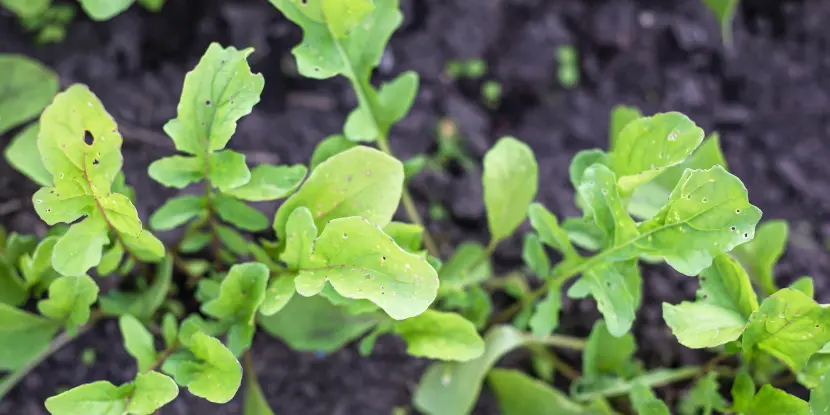
Young arugula leaves damaged by pests.
Companion Planting
Companion planting involves placing plants near each other for mutual benefit. These may include enhanced growth, improved pest control, and better pollination.
The best companion plants for arugula include:
- Bush beans and peas fix nitrogen in the soil, which enriches it.
- Carrots can aerate the soil around the arugula, which promotes root development and healthy growth.
- Cucumbers have broad leaves that offer shade in hotter climates.
- Lettuce helps maximize space in the garden and creates a natural pest deterrent, since pests are less likely to attack a diverse planting.
- Mint has a strong scent that repels aphids, flea beetles, and other common pests.
- Radishes are a trap crop for flea beetles, drawing them away from arugula plants.
Harvesting Arugula
Arugula grows fast, usually maturing in 3-4 weeks when grown from seed.
- Leaves are ready for harvest when 2-3 inches long. You can cut individual leaves or harvest the entire plant.
- For a continual harvest, practice “cut and come again” by trimming only the outer leaves and allowing the center leaves to continue growing.
- Use sharp scissors or a knife to cut the leaves cleanly and minimize damage to the plant.
- Harvesting in the morning when temperatures are cooler preserves the leaves’ crispness and flavor.
- Regular harvesting encourages the plant to produce more leaves and a bountiful crop.
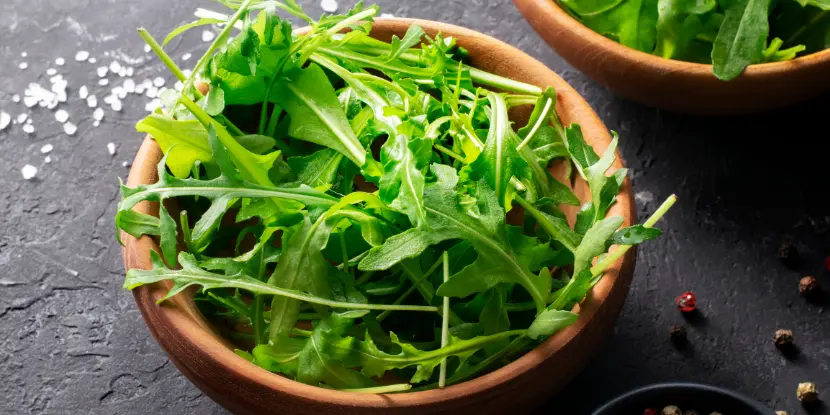
Freshly harvested arugula ready for the salad.
Winterizing Arugula
To protect plants from frost, cover them with row covers or cloches. These covers trap heat and insulate plants, extending the growing season.
- If temperatures are predicted to drop below 20°F (-6°C), harvest all remaining arugula before the freeze.
- Alternatively, you can transplant young seedlings into containers and bring them indoors until the frost passes.
FAQs: Growing Arugula
Q: Can I grow arugula in containers on a balcony?
Arugula does well in containers with sufficient sunlight, water, and nutrients.
Q: How often should I water my arugula plants?
Water arugula plants deeply once or twice a week, depending on the weather conditions.
Q: What can I do with arugula flowers?
Arugula flowers are edible and can garnish salads or add color to dishes.
Q: Is arugula easy to grow from seeds?
Yes, arugula seeds are easy to germinate and grow, making them suitable for beginner gardeners.
Q: Can I plant arugula alongside other vegetables in my garden?
Arugula makes an excellent companion plant for many vegetables and herbs, enhancing their growth and flavor.
Q: How can I prevent my arugula from bolting too quickly?
Plant it in cooler parts of the garden and provide sufficient water. Bolting often occurs due to high temperatures, so using shade cloths during the hottest parts of the day can also help.
Q: Can arugula be grown indoors year-round?
Yes, with adequate light. If natural sunlight is limited, consider using grow lights to ensure your plants receive at least 6 hours of light per day.
Q: Do I need to thin my arugula seedlings?
Thinning prevents overcrowding and promotes healthy growth. Once they have a few true leaves, aim to thin seedlings to about 3-4 inches apart.
Q: What should I do if my arugula leaves start turning yellow?
Yellowing arugula leaves can indicate over-watering, poor drainage, or a nutrient deficiency. Check the soil moisture, adjust as needed, and consider a soil test to determine if additional nutrition is necessary.
Q: Can arugula survive a frost?
Arugula is somewhat frost-tolerant and can survive light frosts without protection. For harder frosts, row covers or cloches can offer protection to extend the growing season.

